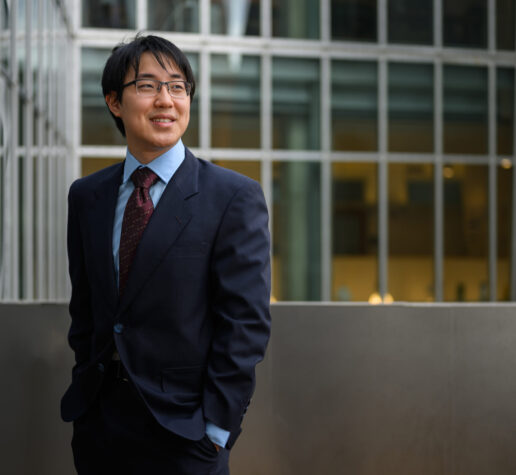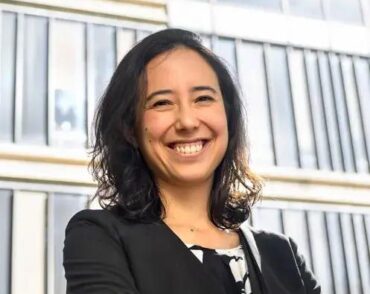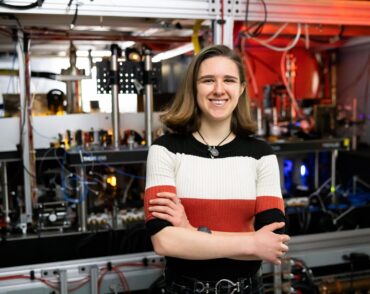
Envisioning a time when people age without fear of dementia
Moved by the human devastation and scientific conundrum of Alzheimer’s, William Li seeks to work on therapies for the disease.
The mathematician and computer scientist Richard Hamming once gave a talk about doing great research. “He who works with the door open gets all kinds of interruptions, but he also occasionally gets clues as to what the world is and what might be important,” Hamming said, emphasizing the importance of open-mindedness and scientific development.
William Li came across this quote as a high school student seeking to dedicate himself to research but unsure how to begin. “I think that science is kind of an opaque area to break into. It’s hard to know what you’re supposed to be doing from time to time,” Li explains.
A double-major in physics and computer science, Li has taken this advice to heart. Keeping his “office door” open has led him to a variety of research projects, from neuroimaging to genomics, that shaped his long-term goal: to become a physician-scientist who moves the needle on Alzheimer’s disease.
Li’s interest in working with patients in a clinical setting was spurred by his grandfather, who was a doctor. In high school, he began volunteering in retirement homes and at the Byrd Alzheimer’s Center and Research Institute at the University of South Florida. Through this work, Li witnessed the devastating effects Alzheimer’s disease has on both those diagnosed and their loved ones.
But that isn’t the only thing about Alzheimer’s that has grabbed his interest. With no cure available, and relatively little known about its cause, the disease is also a compelling scientific problem. “Beyond its human impact, Alzheimer’s represents a frontier of our understanding of human disease,” Li says.
Starting in the fall, Li will begin an MD/PhD program “for the better part of the coming decade.” Following that, he hopes to secure a residency in radiology or neurology, and then to teach and do research while simultaneously practicing medicine. His ultimate goal is a big one — to help develop a cure for Alzheimer’s.
Pursing knowledge
Research has been the highlight of Li’s career at MIT. He says, “To me personally, research means being able to contribute to a body of knowledge built upon by generations of minds in the past. I see modern science and technology as a pinnacle of human achievement, and it’s a dream come true to be able to add to this work.”
In a normal week during the academic semester, Li can spend up to 15 hours in the lab. His research projects have addressed very different topics, but both have guided him toward his current goals.
In the Soljačić and Johnson groups in the Research Laboratory of Electronics, Li he has worked in nanophotonics, a field concerned with controlling light by designing structures the size of a wavelength, for optical and X-ray images, among other applications.
Li has worked on making X-ray imaging safer and more effective for medical screenings. He also focuses on using computational methods to design nanophotonic device elements for higher-resolution imaging. “Imaging technologies in the future will have pretty enormous applications both for understanding disease and for being able to catch diseases early through diagnosis,” he says.
In his sophomore year, Li began working at the lab of Professor Manolis Kellis at the Broad Institute of MIT and Harvard, using computational tools to study genetic variation among Alzheimer’s patients and how this relates to the disease itself. In this way, the disease can be broken down into subtypes, explains Li, which will make it easier to understand and treat. Last summer, Li won a SuperUROP Outstanding Research Award for this project.
Forging connections
When Li first joined the Kellis lab, the field of genomics seemed vast and overwhelming. To combat this, he started an academic journal club. In the club, Li and his peers would read research papers together and discuss them. In the fashion of a traditional journal club, one person would present at each meeting. Club participants encouraged each other to focus on any research they found exciting, ranging over the past century. As the club has continued, members have started to present their own research to the group as well. “It’s fun seeing what my friends are interested in,” Li says.
Li also served as the collegiate relations co-chair of MIT’s Pre-Medical Society. Here he was responsible for organizing an annual meeting between all pre-med students of the greater Boston area. This mixer was held for pre-med students to other local students and learn from pre-medical advisors and alumni of various Boston schools.
Among the several communities Li is a part of at MIT, his dormitory holds a special place in his heart. Next House, MIT’s largest dorm building, is the place Li has called home since his junior year. Since moving in, he has immersed himself in the living community by assuming roles in several activities hosted by the dorm, such as Thanksgiving dinner.
“I’m very happy to be part of the Next House community. It’s a pretty fantastic place, and I would say that my quality of social life has increased a lot since moving here,” he states.
Along with large events, Li also appreciates the weekly traditions he has created with his Next House friends. Each Sunday, for example, Li joins members of his dorm wing for a 15-minute workout. He says he enjoys exercising in the group setting and frequently attends the gym with his friends, too.
After some downtime on the weekends, Li heads back to the lab and his quest to better understand the brain and how it can be ravaged by dementia. As he continues on his path toward becoming a researcher and physician, he envisions a world where people can age without fear of illness.


